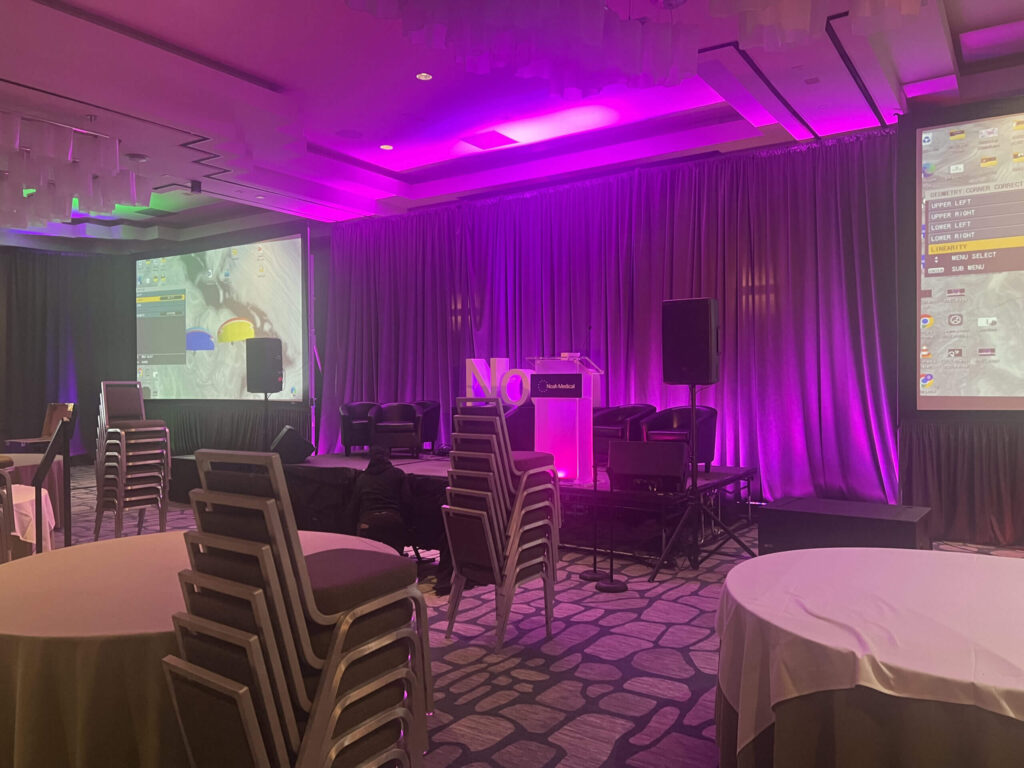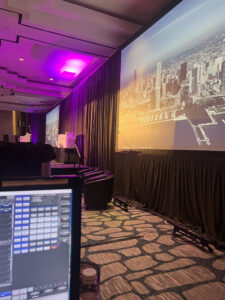Audiovisual mistakes can break your entire event. Whether you’re running a corporate conference, hybrid seminar, product launch, or live streaming event, your audio visual production setup needs to work flawlessly. When something breaks, cuts out, or fails to connect, the audience notices. The impact is immediate: dropped attention, frustration, and damage to your brand’s credibility.
Once the audience is in their seats, it’s too late to fix missing cables, distorted sound, or missing visual cues. That’s why AV planning isn’t just about tech, it’s about timing, communication, and anticipating every signal path and connection point.
In this blog, we will walk you through common AV mistakes and tips on how to avoid them. Each section focuses on a specific mistake, how it impacts your event, and what to do instead.
1. Incorrectly Formatting Your Visual Content
Poorly formatted visual content can wreck a smooth event. This happens when files don’t play correctly, media looks distorted on screen, or fonts and graphics are misaligned. Common AV Mistakes issues come down to improper file types, screen ratios, or presentation software compatibility.
Another common mistake is using high-resolution videos or animations that the AV system can’t handle smoothly. This causes stuttering or freezing mid-presentation.
Your slides, videos, and images might look perfect on your laptop, but that doesn’t mean they’ll display right on a projector or LED screen. Wrong aspect ratios, unsupported file types, or embedded fonts can all lead to broken visuals.
Stick to commonly supported formats like .MP4 for video and .JPG or .PNG for static images. Avoid massive file sizes unless your AV team confirms their system can handle it.
This is what you should do:
- Standardize your visual content. Create presentations using formats that are widely supported, like PowerPoint (.pptx) or PDF. Avoid exotic file types or embedded media that rely on specific programs.
- Test your files in advance on the actual equipment that will be used. Always bring a local copy of your content on a USB drive, and provide it to the AV team ahead of time so they can preload and verify it.
- If your speaker insists on using their laptop, confirm compatibility with the venue’s system and cables. Request a run-through before the event so the AV team can address any format or playback issues.
2. Ignoring Power Costs
One of the most overlooked Common AV Mistakes is ignoring the cost and supply of electrical power. Without accurate planning, you could face power outages, blown circuits, or unexpected surcharges from the venue. Many organizers underestimate the draw of lighting, video walls, projectors, audio gear, and charging stations. When too many devices run off the same power source, it leads to overloads and shutdowns.
Unexpected costs also come into play. Venues often charge extra for dedicated circuits, generators, or additional labor to install power drops. If these items aren’t in your budget from the start, they can wreck your financial plan. Delayed planning might mean settling for less-than-ideal power setups, which can lead to flickering screens, a hum in your audio system, or a complete system failure.
This is what you should do:
- Work with your AV provider early to calculate your full power needs. Add up the draw of every piece of gear, from LED lights to microphones to control consoles. Then share those numbers with the venue to get exact quotes on what additional power setups are needed.
- Ask for a clear breakdown of what’s included and what’s considered an extra cost. This will help avoid surprises. Make sure there are backup power options in case of a failure; this could be a UPS for your control systems or a generator for larger events.
- Be specific about where you’ll need power access, especially for staging areas, screens, and speaker stations. And don’t forget to factor in Wi-Fi routers, media servers, and mobile charging points for attendees. Planning power early and thoroughly will save you money and avoid event-day disruptions.
3. Having Too Few Audio Inputs
Too few audio inputs can ruin the flow of your event. This mistake shows up as last-minute scrambling to unplug one microphone to use another, or not being able to connect music, videos, or remote participants into the sound system.
Also, not all mixers are the same. Some small ones may only have 4–6 inputs, which isn’t enough for even a basic panel discussion with multimedia presentations. If your event has more than a few sources of sound, you’ll need a larger digital console with 12 or more inputs, sometimes even 32 or more for bigger productions.
What you should do:
- Count all your possible audio sources in the earliest stages of planning. Include wireless microphones, handheld mics, lapels, music inputs, video playback, audience questions, and even backup channels. Share this list with your AV team and confirm that the soundboard and audio system can support them.
- Make sure the system has the flexibility to expand. It’s better to have more inputs than you think you’ll need. That gives your AV technicians room to adjust on the fly. Ask about digital mixers with expandable channels if you anticipate growth. Never assume the venue’s setup will meet your needs; ask specifically how many inputs they provide.
- Prepping your audio inputs correctly prevents a mess of signal confusion and gives every sound source a clear place in the mix.
4. Having Too Few or The Wrong Visual Inputs
Not having enough visual inputs or having the wrong kind can completely derail a presentation or panel. This often results in last-minute cable swaps, people not being able to present, or blank screens that damage your audience’s confidence.
Not all inputs are created equal. Some devices output HDMI, others DisplayPort, USB-C, VGA, or SDI. If the switcher doesn’t support a certain input type, you’ll need a converter. Skip this step, and you’re left with a device that can’t connect on show day.
Also, factor in the resolution and refresh rates of each source. If one device runs at 1080p and another outputs 4K, your video switcher and projectors must be able to accept and scale those feeds correctly. Incompatible resolutions can lead to flickering, delay, or no signal at all.
More visual inputs also mean better flexibility. If your speaker suddenly wants to use a second laptop or demo a new app, you’ll be ready instead of scrambling to unplug something else.
What you should do:
- First, inventory every visual source you plan to use, like laptops, cameras, streaming devices, and backup media players. Note what types of outputs they use (HDMI, USB-C, SDI, etc.). Share this list with your AV team and confirm the input capacity of your video switcher, projector, or LED wall processor.
- Ask if additional gear like HDMI splitters, signal converters, or matrix switchers is needed. Build in extra inputs for late changes or additions. If live cameras are involved, confirm that your system supports real-time switching without lag.
- Lastly, label and test all visual inputs during rehearsal. This prevents last-minute scrambling and keeps your content flowing smoothly. Having the right visual inputs means your visuals appear on cue and at full quality, without interruption.
5. Delaying The Hiring of Your AV Team
Waiting too long to hire for your AV team can lead to Common AV Mistakes. Delays lead to rushed planning, limited gear availability, higher costs, and missed opportunities to design an effective audiovisual setup.
Rushed AV planning also reduces testing and rehearsal time. Your team might not get to walk the space, test the signal flow, or catch problems like signal interference, poor sightlines, or bad power distribution. That increases the risk of technical glitches on event day.
If you wait, you may run into limited inventory, especially during peak seasons. The best AV providers get booked months in advance, and by the time you reach out, they may be out of key gear like wireless microphones, video switchers, or LED walls. That forces you to compromise or scramble to find another vendor.
What you should do:
- Start to search for an AV vendor as soon as you lock in your venue and event date. Involve your AV team early in the planning process so they can advise on equipment needs, venue limitations, and timelines. Early hiring lets the AV professionals coordinate with event planners, speakers, and production designers to craft a seamless experience.
- Set clear communication channels and schedule rehearsal time to work through technical runs well before the event. Early planning means your AV team can manage equipment orders, perform on-site tests, and adapt to changes without pressure. This proactive approach reduces risks, controls costs, and guarantees smooth audio-visual performance on the big day.
6. Ignoring the Setting Up Your Wi-Fi
Failing to plan for Wi-Fi can ruin streaming, cause delays in presentations, and frustrate attendees who rely on connectivity. Wi-Fi isn’t just for checking email anymore; it powers live streaming, mobile apps, cloud-based presentations, speaker notes, audience polls, and hybrid event platforms.
If you’re hosting a hybrid event or relying on remote speakers, ask for hardwired connections. Wi-Fi can drop unexpectedly, but Ethernet is more stable. Your AV team needs priority access to wired internet to run critical components like streaming encoders and video conferencing.
Always check the signal in advance to avoid Common AV Mistakes. Wi-Fi may be fine in the hallway, but weak in the ballroom. Conduct a site survey with your AV provider and venue techs to verify strength in all key areas, including stage, backstage, registration, and breakout rooms.
What you should do:
- Work with your AV provider and venue tech staff early to assess Wi-Fi needs based on attendee numbers and device usage. Set up a dedicated, high-capacity network specifically for AV equipment and streaming. Segment networks to separate guest access from production traffic, reducing interference.
- Test the network under load before the event to catch weak spots or bottlenecks. Provide wired connections for key AV devices whenever possible to ensure stable signals. Have backup options like portable hotspots or additional access points ready in case of failure.
- Proper Wi-Fi setup keeps your event connected, smooths live streaming, and supports every tech element that relies on the internet. Don’t leave your network to chance; plan it as carefully as your AV gear.
7. Not Having The Proper A/V Outputs
Missing or mismatched A/V outputs can break your entire setup. If your outputs don’t align with your display devices, projectors, or streaming gear, your visuals and sound won’t reach the audience correctly or at all.
Each output should match the device it connects to in terms of resolution and format. For example, sending a 4K signal to a 1080p display without conversion can cause blank screens. Check the technical specifications of each component to guarantee compatibility.
If you’re using multiple displays or routing signals through a matrix switcher, plan the output flow carefully. One wrong format or mismatched output can block the signal across the entire chain. Use a signal flow diagram during planning and setup.
Don’t overlook audio outputs either. If your audio is routed separately from video, like from a mixer to powered speakers or a broadcast encoder, confirm you have the correct connectors and levels (balanced vs. unbalanced, analog vs. digital).
What you should do:
- Identify all devices needing output connections early, such as laptops, cameras, playback devices, speakers, and streaming gear. Match their output formats with the venue’s AV equipment capabilities.
- Work with your AV team to include adapters, converters, or splitters in your setup if needed. Confirm that your system can handle multiple outputs to serve different screens or audio zones simultaneously.
- Test every connection before the event to catch compatibility problems early. Planning your outputs carefully guarantees smooth content delivery and avoids frustrating technical hiccups during the show.
8. Not Planning Your Rigging Points
Failing to plan for rigging points causes major delays and safety issues. Without proper rigging, lighting trusses, video walls, speaker arrays, or overhead decor can’t be suspended, or worse, they get placed unsafely. You risk violating venue restrictions, delaying setup, or needing expensive last-minute adjustments.
Many venues have limited load-bearing points in the ceiling. If your design requires rigging in specific spots, but those points don’t exist, your entire production design may need to be redone. Rigging also often requires permits, union labor, or specialized engineers. Waiting until the last minute guarantees missed deadlines or extra costs.
Here’s what you should do:
- Request the venue’s rigging plot and weight limits as soon as your event layout is being developed. Share these with your AV company and production team immediately. Make sure your design fits within those limitations. If needed, revise your floor layout or switch to ground-supported structures early in planning.
- Confirm labor requirements. Some venues need you to use approved riggers or union staff. Schedule them well in advance. Ask if any permits or safety checks are required and factor those into your event timeline.
- Pre-rig the day before if possible. This allows rigging teams to work without interfering with other setups and saves time on show day. Include time for a safety inspection and test lift before any equipment is hung.
9. In-House or External AV Supplier
Choosing between an in-house AV team and an external AV supplier can make or break your event. Many planners default to the venue’s in-house AV provider because it’s convenient. But convenience doesn’t always equal quality or cost efficiency.
The problem with in-house AV is that you’re often locked into high rates with limited flexibility. In many cases, you’re paying a premium for basic equipment and standard services. You may also be restricted by the venue’s contracts, which can limit negotiation or customization.
In-house teams are familiar with the venue. But if your event has specific needs like live streaming, complex audio-video production, interactive displays, or hybrid event setups, the in-house team might not have the expertise or inventory to support it. You could end up renting from third parties anyway, at higher costs and with more coordination headaches.
External AV suppliers often bring deeper experience, more advanced gear, and flexible packages that can fit your event’s technical requirements and budget. But choosing an outside vendor means you must factor in logistics like access, power availability, and setup time. Some venues charge extra fees, called “corkage” or “buyout” fees, if you bring your AV team, which can impact your budget.
This is what you should do:
- Evaluate the scope of your AV needs early in the planning process. For basic events, in-house AV may be enough. But for corporate events, multi-day conferences, or anything requiring a complex audiovisual setup, compare in-house quotes with external AV suppliers.
- Ask for references or past work samples. If your event includes multimedia presentations, staging, live streaming, or audience engagement tools, external suppliers may offer more experience and better tools.
- If you choose an external AV company, communicate with the venue early to understand any restrictions or fees. Include your AV supplier in site visits and walkthroughs so they can plan around any venue-specific requirements.
10. Compromising On Audio Quality
Poor audio is one of the fastest ways to lose your audience. When sound is too low, distorted, or inconsistent, people stop paying attention. They might miss key details, tune out completely, or leave early. If your audio setup can’t handle the space, audience size, or number of speakers, your event will suffer, no matter how great the visuals are.
Another issue is relying on the venue’s default audio gear without understanding its limitations. Built-in systems may not support wireless microphones, audio mixing, or multiple inputs needed for guest speakers, panels, or video playback. Echoes, feedback, and dropouts are common problems when the wrong equipment or poor microphone placement is involved.
Inconsistent sound levels between videos, speakers, and music cues confuse the audience. So do poorly managed audio transitions. Bad sound doesn’t just affect live audiences. If you’re recording or live streaming, low-quality audio ruins your content and damages your brand.
This is what you should do:
- Start your event planning with sound in mind. Assess your audience size, venue layout, and session format.
- Work with AV technicians who understand the acoustics of your venue and can recommend the right gear. Invest in reliable wireless microphones and audio mixing equipment. Test every input, and build in time for a full sound check.
- Never treat audio as an afterthought. It shapes how people experience your message. Good sound equals strong engagement and high-quality production value.
11. Not Planning Setup Time
Underestimating setup time is one of the most common planning mistakes in event production. People assume AV teams can arrive, plug in a few cables, and be ready to go. But in reality, a proper setup for audiovisual setup takes hours, sometimes an entire day, depending on the scale of the event.
Problems happen fast when there’s no buffer in the schedule. Rushing leads to incomplete sound checks, missed lighting cues, and video content that won’t play correctly. There might be last-minute equipment failure, bad cable management, or projector setup issues that require troubleshooting. Without time, your AV team can’t fix these problems before doors open.
Delays also affect other vendors. If staging isn’t finished, lighting can’t be rigged. If the screens aren’t mounted, visual inputs can’t be tested. When setup is rushed, quality drops and mistakes increase.
This is what you should do:
- Build a detailed production timeline early. Talk with your AV technicians and get clear estimates on how long setup and tear-down will actually take, not just best-case scenarios.
- Schedule rehearsals the day before if possible, especially for complex sessions with guest speakers or multimedia presentations.
- If possible, do a full walk-through with your AV team, staging company, and event coordinator before event day. Confirm the order of setup: staging, lighting, audio, then video. Make sure the power supply is ready before the equipment arrives.
12. Cutting Corners On Quality
Many event planners assume cheaper gear or fewer technicians will be “good enough,” especially if the event seems simple. But trying to save a few dollars often means equipment failure, inconsistent performance, and a poor attendee experience.
One common issue is renting outdated or low-end equipment that can’t deliver clean visuals or crisp sound. This includes projectors that aren’t bright enough for your venue, speakers that distort at high volume, or microphones that drop signal. Cheap gear may technically function, but it won’t perform well under pressure or in challenging environments.
Another mistake is reducing crew size to save on labor costs. A small team might not be able to troubleshoot fast enough or respond to problems as they happen. If a cable fails, a mic cuts out, or a screen needs to be realigned mid-event, there won’t be enough hands to fix it quickly.
This is what you should do:
- Define your event goals and technical needs clearly, then match them with the right level of AV support. If your event involves corporate clients, recordings, or large audiences, don’t use low-tier equipment or an understaffed crew.
- Choose a supplier with a proven track record. Ask for equipment specs and make sure all gear is rated for the size of your venue and number of attendees.
- Do smart spending focusing on the elements that impact audience experience the most: clear sound, visible screens, stable internet, and seamless transitions. Spend less on decor if needed, but not on core AV functions.
13. Neglecting Your AV Team
Neglecting your AV team during planning and execution is a mistake that causes delays, confusion, and last-minute hassles. When your technicians are left out of conversations or treated as an afterthought, they don’t have the information or time they need to prepare for showtime.
One major problem is a lack of communication. If the AV crew doesn’t know about the changes to the schedule, speaker lineup, or presentation order, they won’t be ready. This can lead to mismatched content, missing inputs, or blank screens. Another issue is giving the team too little time to rehearse or test systems, which increases the chances of technical glitches.
This is what you should do:
- Treat your AV team like a strategic partner, not just a vendor. Bring them into planning meetings early. Share your event goals, session formats, and venue details.
- Build in time for rehearsals and sound checks. Give them the chance to run their systems and address any issues before guests arrive.
- Assign a point person from your team to coordinate directly with your AV lead. This avoids missed messages and last-minute scrambling. Great events are a team effort, and your AV crew needs to be on the same page to deliver seamless execution.
14. Skipping Equipment Backups
Skipping backup equipment is one of the most common ways to put your event at risk. Many teams assume that if everything tests fine during setup, the gear will perform without fail. But live events are unpredictable, and technical problems can happen at any time, and without a backup, there’s no safety net.
A common issue is relying on a single laptop for content playback. If it crashes mid-presentation, your speaker is left with no slides and a silent room. Another frequent problem is using just one wireless microphone. If the batteries die or the signal drops, your keynote speaker is suddenly inaudible. Projectors, switchers, and streaming encoders can also fail under stress, especially during long or complex programs.
Events that involve remote participation or live streaming add another layer of risk. A single internet connection without a backup line puts the entire broadcast in jeopardy. And if your streaming encoder fails, you may lose the whole recording or feed, with no chance to recover it.
This is what you should do:
- Always build redundancy into your AV setup. For every critical piece of gear—mics, laptops, projectors, encoders have a spare ready to go. Set up backup systems ahead of time and test them just like your primary equipment.
- Use battery backups (UPS systems) for sensitive gear so that a power surge doesn’t shut you down. Have extra batteries, chargers, and cables within arm’s reach.
- Communicate with your AV team about backup plans before the event. Assign roles so that if something goes wrong, everyone knows what to switch, reboot, or replace immediately.
15. Incorrect Formats for Presentations
Wrong presentation formats cause major delays, technical errors, and awkward moments during events. If a presenter brings a file that isn’t compatible with the AV system, it may not load properly, or at all. This forces the AV team to scramble to convert or reconfigure settings on the spot, which leads to Common AV Mistakes.
One common issue is when a speaker shows up with a Mac-based file that doesn’t display correctly on a Windows machine. Fonts, layouts, or animations may break. Another issue is videos embedded in presentations that don’t play due to unsupported codecs or file paths that only work on the original device. PDF files with multimedia, overly complex slide transitions, or outdated file formats can also trip up playback. This is an example of a Common AV Mistake.
When formats aren’t tested in advance, there’s no time to troubleshoot. This can lead to blank screens, distorted visuals, or frozen slides while the tech crew tries to patch things together. The result? Embarrassed speakers, bored audiences, and lost momentum. This is a classic Common AV Mistake.
This is what you should do:
- Set presentation format guidelines for all speakers ahead of time. Specify preferred file types (e.g., PowerPoint, .pptx, MP4 for videos), screen resolution requirements, and whether animations or audio will be used. Share these specs early so presenters can prepare correctly.
- Schedule a tech check where all files are tested on the actual playback system. Encourage speakers to bring their files on USB drives and email a copy as a backup.
- Good prep avoids bad surprises. The right file format is more than a detail—it’s what makes smooth, stress-free presentations possible.
Most of these mistakes occur from poor planning, late decisions, bad assumptions, or cutting costs in the wrong places. That’s why it’s important to partner with a professional AV provider who understands your event’s unique needs. Before choosing a provider, be sure to explore these 7 Important Questions to Ask Your AV Company Before Hiring in Atlanta to avoid these common mistakes from the start.
Conclusion
Audiovisual problems don’t just harm your event; they also damage your message, reputation, and attendee experience. These issues aren’t just technical; they’re planning failures.
Huview Productions is a full Audio Visual Production company in Atlanta that understands these challenges and delivers seamless solutions to keep your event running smoothly. We specialize in making sure these problems never reach your stage. Our team handles the tech so you can focus on the message.
Don’t wait until something breaks to fix it. Plan smarter. Execute better. Let Huview take your event to the next level. Contact us today to get started.
What are the most common AV mistakes at events?
Some of the most common AV mistakes include incorrect file formats, insufficient power planning, too few audio/visual inputs, poor Wi-Fi setup, and skipping rehearsals. These issues often stem from poor planning or late-stage decisions.
How early should I hire my AV team?
Ideally, you should hire your AV team as soon as you book your venue. Early involvement allows for proper planning, testing, and coordination with other vendors.
How do I make sure my AV content works on event day?
Always test your presentation on the actual AV setup ahead of time. Provide your content in advance, carry backups on USB drives, and confirm compatibility with the AV team.
Why should I choose Huview Productions for my AV needs?
Huview Productions offers expert AV solutions in Atlanta, with a focus on proactive planning, seamless execution, and reliable technology. We help you avoid common AV pitfalls and deliver a smooth, professional experience.







